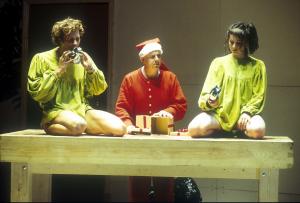The Christmas Show (2001)
Fabulous Beast Dance Theatre
Duration: 100’
electronic score, for the 2001 Dublin Theatre Festival
Directed and Choreographed by Michael Keegan-Dolan
Designer: Juman Malouf
Lighting Design: Tina MacHugh
First performed at the Project Theatre, Dublin, September 2001.
Original Cast: Rachel Lopez de la Nieta, Alex Leonhartsberger, Guy Ryan and Christopher Robson
Michael Keegan-Dolan’s follow-up to The Flowerbed, again for the Dublin Theatre Festival, was The Christmas Show, a fantastic non-linear look at Christmas, contrasting the almost lost world of magic with our dreary everyday world of logic. It is rich with memorable and striking images such as a suspended orange cow, red snow, and a Santa drowning in a sea of alarm clocks.
This whole non-linear approach is totally extended to the music. Much of the score is derived from pre-existing music, sourced for its suitability and either adapted, re-arranged or recomposed, creating an eclectic and fantastic musical pandora’s box, a kind of aural Christmas stocking, if you like. The piece starts with the sound of Abruzzan pipes, which Feeney will have associated with Christmas from his time in Italy when the shepherds come down from the hills to play their pipes in the streets of Rome. He subjects their pipe music to a process of deconstruction and re-composition, so in the end it is the sound of the pipes rather than their melodic structure that is most evident. Other sourced music undergoes similar processes, whether it comes from Peer Gynt, Tea for Two or even high octane jazz in the manner of Miles Davies. Purcell’s O Wondrous Machine is rescored for an extraordinary ensemble of harpsichord, sampled cello and multiple alarm clocks.
Keegan-Dolan had managed to solicit the services of Christopher Robson, whose powerful counter-tenor voice added a whole new dimension to the score. His first aria was sung from perilously high in the gantry, creating genuine spatial polyphony, a real where’s-that-coming-from moment. In need of words for this song, the composer raided his Carols for Choirs and chose to set the odd unconnected Latin phrases that occur in carols such as In Dulci Jubilo, creating a veneer, a thin layering of icing, of the liturgical, of something known and loved and yet alien.
This interesting mix of the comfortable and the strange is musically enhanced by the blending of different mutually exculsive styles. There are influences from Indian classical music, and the superimposition of baroque harpsichord over a raga rhythm makes for a unique musical sound. An otherwise benign circular piano solo in 5/8 over a limited chord sequence was underscored by sound effects, creating a sense of uneasy restlessness.
This piano solo gave us a headache in the final production days at the Project Theatre. It was the period immediately prior to software instruments, so to complete the final edits and clean-ups we needed to get hold of a real digital piano. In the end it meant transporting all kinds of gear to the Beckett Theatre at Trinity College in order to do an emergency recording session.

